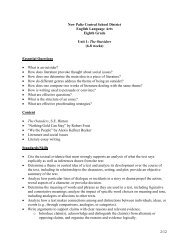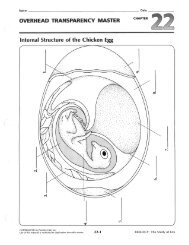Medieval Europe Quiz - New Paltz High School
Medieval Europe Quiz - New Paltz High School
Medieval Europe Quiz - New Paltz High School
- No tags were found...
You also want an ePaper? Increase the reach of your titles
YUMPU automatically turns print PDFs into web optimized ePapers that Google loves.
26. Base your answer to the following question on the<br />
illustration below and on your knowledge of social<br />
studies.<br />
In both <strong>Europe</strong> and Japan, the major reason for the<br />
development of the political system shown in the<br />
illustration was to<br />
A) increase trade and manufacturing in the region<br />
B) provide order during a period of weak central<br />
governments<br />
C) consolidate the political power of religious leaders<br />
D) eliminate the need for a legal system<br />
27. In <strong>Europe</strong>an feudal society, an individual's social status<br />
was generally determined by<br />
A) individual abilities<br />
B) education and training<br />
C) marriage<br />
D) birth<br />
28. Which economic system existed in <strong>Europe</strong> during the<br />
early Middle Ages?<br />
A) free market B) socialism<br />
C) command D) manorialism<br />
29. The growth of feudalism in <strong>Europe</strong> during the Middle<br />
Ages was primarily caused by the<br />
A) suppression of internationalism<br />
B) collapse of a strong central government<br />
C) decline of the Roman Catholic Church<br />
D) rivalry between the colonial empires<br />
30. Which statement about the social structure in <strong>Europe</strong><br />
during the Middle Ages is most accurate?<br />
A) The nobles encouraged social mobility.<br />
B) The practices of the Catholic Church led to the<br />
development of a classless society.<br />
C) Industrialization led to the growth of socialism<br />
throughout <strong>Europe</strong>.<br />
D) Sharp class distinctions divided <strong>Europe</strong>an society.<br />
31. One similarity between the feudal manors of <strong>Europe</strong><br />
and the traditional villages of India is that<br />
A) peasants were seldom able to change their social<br />
status<br />
B) women dominated the political decisions of the<br />
local councils<br />
C) children could choose from a number of different<br />
occupations<br />
D) monarchs exerted absolute power over local<br />
governments<br />
32. Which institution served as the primary unifying force<br />
in medieval western <strong>Europe</strong>?<br />
A) militar B) legislature<br />
C) church D) monarchy<br />
33. During the early Middle Ages, western <strong>Europe</strong>an<br />
societies were most influenced by<br />
A) elected parliaments<br />
B) national monarchies<br />
C) the Byzantine emperors<br />
D) the Roman Catholic Church













